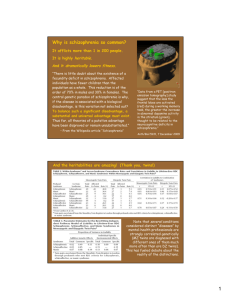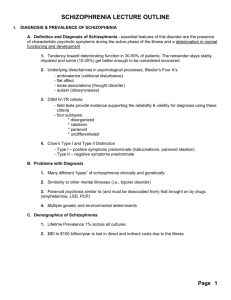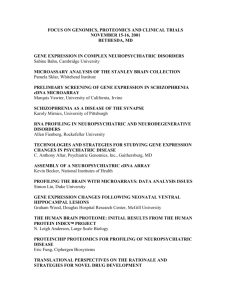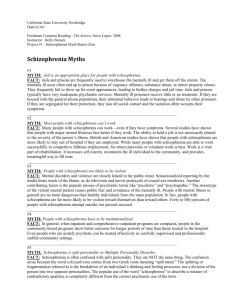Project title
advertisement
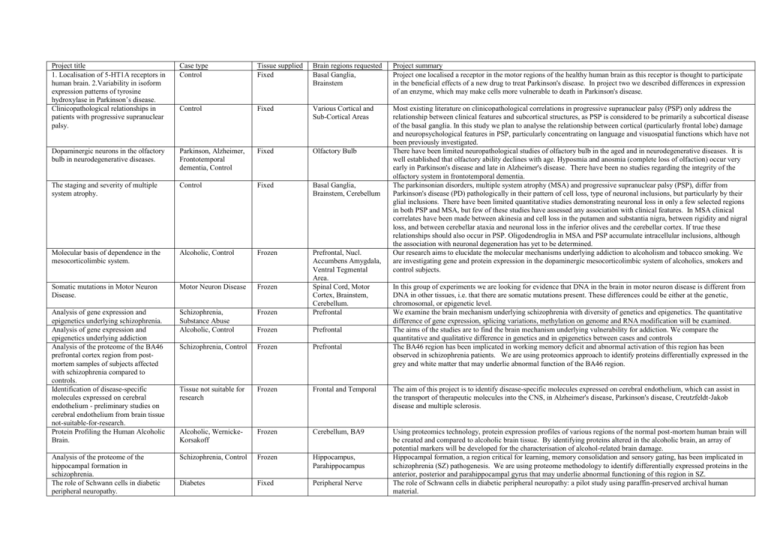
Project title 1. Localisation of 5-HT1A receptors in human brain. 2.Variability in isoform expression patterns of tyrosine hydroxylase in Parkinson’s disease. Clinicopathological relationships in patients with progressive supranuclear palsy. Case type Control Tissue supplied Fixed Brain regions requested Basal Ganglia, Brainstem Project summary Project one localised a receptor in the motor regions of the healthy human brain as this receptor is thought to participate in the beneficial effects of a new drug to treat Parkinson's disease. In project two we described differences in expression of an enzyme, which may make cells more vulnerable to death in Parkinson's disease. Control Fixed Various Cortical and Sub-Cortical Areas Dopaminergic neurons in the olfactory bulb in neurodegenerative diseases. Parkinson, Alzheimer, Frontotemporal dementia, Control Fixed Olfactory Bulb The staging and severity of multiple system atrophy. Control Fixed Basal Ganglia, Brainstem, Cerebellum Molecular basis of dependence in the mesocorticolimbic system. Alcoholic, Control Frozen Somatic mutations in Motor Neuron Disease. Motor Neuron Disease Frozen Analysis of gene expression and epigenetics underlying schizophrenia. Analysis of gene expression and epigenetics underlying addiction Analysis of the proteome of the BA46 prefrontal cortex region from postmortem samples of subjects affected with schizophrenia compared to controls. Identification of disease-specific molecules expressed on cerebral endothelium - preliminary studies on cerebral endothelium from brain tissue not-suitable-for-research. Protein Profiling the Human Alcoholic Brain. Schizophrenia, Substance Abuse Alcoholic, Control Frozen Prefrontal, Nucl. Accumbens Amygdala, Ventral Tegmental Area. Spinal Cord, Motor Cortex, Brainstem, Cerebellum. Prefrontal Most existing literature on clinicopathological correlations in progressive supranuclear palsy (PSP) only address the relationship between clinical features and subcortical structures, as PSP is considered to be primarily a subcortical disease of the basal ganglia. In this study we plan to analyse the relationship between cortical (particularly frontal lobe) damage and neuropsychological features in PSP, particularly concentrating on language and visuospatial functions which have not been previously investigated. There have been limited neuropathological studies of olfactory bulb in the aged and in neurodegenerative diseases. It is well established that olfactory ability declines with age. Hyposmia and anosmia (complete loss of olfaction) occur very early in Parkinson's disease and late in Alzheimer's disease. There have been no studies regarding the integrity of the olfactory system in frontotemporal dementia. The parkinsonian disorders, multiple system atrophy (MSA) and progressive supranuclear palsy (PSP), differ from Parkinson's disease (PD) pathologically in their pattern of cell loss, type of neuronal inclusions, but particularly by their glial inclusions. There have been limited quantitative studies demonstrating neuronal loss in only a few selected regions in both PSP and MSA, but few of these studies have assessed any association with clinical features. In MSA clinical correlates have been made between akinesia and cell loss in the putamen and substantia nigra, between rigidity and nigral loss, and between cerebellar ataxia and neuronal loss in the inferior olives and the cerebellar cortex. If true these relationships should also occur in PSP. Oligodendroglia in MSA and PSP accumulate intracellular inclusions, although the association with neuronal degeneration has yet to be determined. Our research aims to elucidate the molecular mechanisms underlying addiction to alcoholism and tobacco smoking. We are investigating gene and protein expression in the dopaminergic mesocorticolimbic system of alcoholics, smokers and control subjects. Frozen Prefrontal Schizophrenia, Control Frozen Prefrontal Tissue not suitable for research Frozen Frontal and Temporal The aim of this project is to identify disease-specific molecules expressed on cerebral endothelium, which can assist in the transport of therapeutic molecules into the CNS, in Alzheimer's disease, Parkinson's disease, Creutzfeldt-Jakob disease and multiple sclerosis. Alcoholic, WernickeKorsakoff Frozen Cerebellum, BA9 Analysis of the proteome of the hippocampal formation in schizophrenia. The role of Schwann cells in diabetic peripheral neuropathy. Schizophrenia, Control Frozen Hippocampus, Parahippocampus Diabetes Fixed Peripheral Nerve Using proteomics technology, protein expression profiles of various regions of the normal post-mortem human brain will be created and compared to alcoholic brain tissue. By identifying proteins altered in the alcoholic brain, an array of potential markers will be developed for the characterisation of alcohol-related brain damage. Hippocampal formation, a region critical for learning, memory consolidation and sensory gating, has been implicated in schizophrenia (SZ) pathogenesis. We are using proteome methodology to identify differentially expressed proteins in the anterior, posterior and parahippocampal gyrus that may underlie abnormal functioning of this region in SZ. The role of Schwann cells in diabetic peripheral neuropathy: a pilot study using paraffin-preserved archival human material. In this group of experiments we are looking for evidence that DNA in the brain in motor neuron disease is different from DNA in other tissues, i.e. that there are somatic mutations present. These differences could be either at the genetic, chromosomal, or epigenetic level. We examine the brain mechanism underlying schizophrenia with diversity of genetics and epigenetics. The quantitative difference of gene expression, splicing variations, methylation on genome and RNA modification will be examined. The aims of the studies are to find the brain mechanism underlying vulnerability for addiction. We compare the quantitative and qualitative difference in genetics and in epigenetics between cases and controls The BA46 region has been implicated in working memory deficit and abnormal activation of this region has been observed in schizophrenia patients. We are using proteomics approach to identify proteins differentially expressed in the grey and white matter that may underlie abnormal function of the BA46 region. Proteomics in the Hippocampus of Alcoholic Human Brain. Alcoholic, Substance Abuse, Cirrhosis, Control Schizophrenia, Control Frozen Hippocampus Analysis of protein expression profile in the hippocampus of alcoholic human brains using proteomics-based approach. Frozen BA9, Temporal Control Frozen Motor Cortex White Matter The roles of adrenoceptors and the intracellular signal transduction proteins in the aetiology of schizophrenic symptoms. Investigation of PARK and associated gene mutations and polymorphisms in autopsy confirmed Lewy body diseases. The neuropathology of white matter hyper-intensities. Schizophrenia, Bipolar Disorder, Control, Depression Frozen BA9, Visual We are investigating the changes to gene expression in post-mortem brains in schizophrenia and controls to better understand what causes the disorder. Multiple system atrophy (MSA) is pathologically characterised by the abnormal deposition of alpha-synuclein in both neurons (also occurs in other neurodegenerative diseases) and oligodendroglia (unique to MSA). Alpha-Synuclein is not normally found in oligodendroglia (Gai et al., 1999), and the intracellular changes to critical oligodendroglial proteins that must occur due to this abnormal process have not been explored This study will investigate the expression of adrenoceptors and their respective intracellular signal transduction proteins in schizophrenia. Parkinson Frozen and Fixed Occipital Pole LRRK2 mutations account for 5% of familial and 2% of sporadic Parkinson's disease (PD). We aim to screen pathological cases of PD for LRRK2 gene mutations to understand any differences in pathological phenotypes. Specified cases Fixed Periventricular & Deep White Matter International collaboration to perform a genome wide association study in autopsy confirmed frontotemporal lobar degeneration with ubiquitin inclusions. Frontotemporal Dementia, Control Frozen Cerebellum, Cortex Mechanisms of neurodegeneration and cognitive impairment induced by alcohol: development of neuroprotective pharmacotherapy. Alcoholic, Control Frozen Hippocampus, Prefrontal Changes in proteomics of brain in schizophrenia. Schizophrenia, Control Frozen BA17, BA9, Caudate. Impaired insulin signalling in brains of chronic alcoholics. Alcoholic, Control Frozen and Fixed Cerebellum, Cingulate. Alzheimer risk and polymorphisms of the folate/ methionine pathway. A novel physiological role for cytochrome P450 enzymes in the brain? Control Frozen Hippocampus Tissue not suitable for research Frozen Membrane phospholipid composition in superior temporal gyrus (STG) of schizophrenia brain. Schizophrenia and Neuropathology of Amygdala. Membrane phospholipid composition Schizophrenia, Control Frozen Frontal, Hippocampus, Amygdala, Basal Ganglia Temporal Lobe The pathological substrate of white matter hyper-intensities (WMH), a common finding on MRI scans of elderly individuals, is unknown. In this study WMH will be investigated histopathologically using a number of markers of vascular integrity. Research has shown that one of the most common pathologies underlying the clinical features of frontotemporal dementia is frontotemporal atrophy with ubiquitin-positive inclusions (FTD-U). The protein/s at the heart of the ubiquitinated inclusions in this disease remains a mystery, even though there is a current world-wide effort to determine their identity. For other neurodegenerative disorders significant clues concerning the proteins involved and their critical processing pathways in the brain have been determined by focusing on genetic determinants. Although FTD-U is a rare disorder, Dr Pickering-Brown’s request to international colleagues currently publishing in the field for the numbers of available autopsy confirmed cases with DNA has determined that 240 FTD-U cases are available world-wide for genetic analyses. As only 20-30% of these cases have a family history of disease, the approach considered most appropriate for genetic analysis of FTD-U is a genome-wide association study. We will participate in this study by contributing sporadic and unique familial cases Our project is focused on transcriptional and cellular mechanisms of neurodegeneration in the human brain in association with alcohol abuse. We found that the NF-kappa B system critical for neuroplasticity and neurodegeneration is dysregulated whereas alterations in the cell suicide machinery contribute to presynaptic injury in the PFC in chronic alcoholics. These adaptations apparently contribute to cognitive impairment associated with alcoholism, and to alcohol dependence. We investigate changes in brain protein expression profiles due to schizophrenia and antipsychotic drugs. The identified proteins will point out on molecular mechanisms for the disease pathogenesis and on potential targets for novel drugs development. The TRC makes available, human alcoholic brain tissue that is in excellent condition and suitable for performing molecular and biochemical studies. Through analysis of the human tissue samples, we were able to determine the degree to which the impairments in insulin signalling observed in experimental rat models of chronic alcohol feeding also occur in human subjects. The research data provided us with new information about how alcohol mediates its adverse effects on brain function. To investigate DNA damage markers and genotyping of polymorphisms within the folate /methionine pathway in Alzheimer patients and in gender and age matched controls. This project involves the characterisation of cytochrome P450 distribution in various regions of the brain. This work is directed towards defining the involvement of these enzymes in metabolism of indole in the human brain. Schizophrenia, Control Frozen Amygdala Schizophrenia, Control Frozen Anterior Cingulate Gene Expression Profiling in Schizophrenia. Investigating changes in myelin associated proteins in multiple system atrophy (MSA). We examined membrane phospholipid composition and neurotransmitter receptor density in the superior temporal gyrus of schizophrenia and control subjects. It was found that there is increased GABAa and reduced muscarinic M1 and M2/4 receptor binding in the STG in schizophrenia. The aim of this project was to investigate the neuronal alterations in the amygdala that are correlated with schizophrenia. This project examined size, shape, and density of brain cells in the amygdala of control and schizophrenia cases. This study examined membrane phospholipid composition and serotonin binding in the anterior cingulate cortex in and 5HT binding efficiency in schizophrenia. Autoimmunity in Schizophrenia. schizophrenia. Altered membrane phospholipid composition and serotonin binding was found. Schizophrenia, Control Fixed Hippocampus, BA9 Proteomics of human post-mortem brain. Analysis of the proteome of the corpus callosum from post mortem samples of subjects affected with schizophrenia compared with controls. 3D Golgi analysis of the prefrontal cortex and hippocampus in schizophrenia/ Immunohistochemical analysis for chromogranin A and B expression in schizophrenia brains. Immunohistochemical analysis for chromogranin A and B expression in schizophrenia brains. The expression of hNP22 in the frontal cortex, the hippocampus and anterior cingulate cortex of schizophrenia. Investigation of the role of the posterior cingulate cortex as an anatomical locus of disturbed neural circuitry in schizophrenia. Glutamate transporters in human hippocampus: alterations in schizophrenia. Alcoholic, Control Frozen Hippocampus Schizophrenia, Control Frozen Corpus Callosum Schizophrenia, Control Fixed Prefrontal, Hippocampus Significant decrease of chromogranin A expression was observed in the brain of schizophrenia. 3D Golgi staining was not stable enough to be used to analyse this type of brain tissue. Schizophrenia, Control Fixed Prefrontal, Hippocampus Significant decrease of chromogranin A expression was observed in the brain of schizophrenia. Schizophrenia, Control Fixed Frontal, Hippocampus, Anterior Cingulate Significant decrease of hNP22 expression was observed in the brain of schizophrenia. Schizophrenia, Control Fixed Posterior Cingulate This project examines neurotransmitter receptors in the posterior cingulate cortex in schizophrenia. To date, we have found specific alterations in glutamatergic, cholinergic, gaba-ergic, serotonergic and cannabinoid systems in this brain region in schizophrenia subjects compared to controls Schizophrenia, Control Fixed Hippocampus, Visual Understanding the molecular basis of bipolar affective disorder. Schizophrenia, Alcoholic, Control Frozen Cerebellum Tachyninin receptors in human brain. Schizophrenia, Control Amygdala Investigate neurological basics of schizophrenia. Molecular cell biology of hNP22: role in alcohol dependence-Amygdala, VTA, NA, PFC. Molecular mechanisms of abnormal acetylcholine neurotransmission in schizophrenia Entorhinal Transcriptome of Schizophrenia Schizophrenia, Control Fixed and Frozen Frozen We have investigated whether there were changes in glutamate transporter expression in the human hippocampus in schizophrenia. We have used a panel of antibodies to examine if there are anomalies in astrocytes in this region. Our findings suggest that there is no clear evidence for an overall anomaly in glutamate regulating proteins but here may be some subtle idiosyncracies. Using tissue from the Australian Brain Donor Programs we have been able to examine the nature of the expression patterns, mRNA splicing, etc of a recently identified bipolar disorder susceptibility gene, the protocadherin FAT. The study is also examining other genes that have altered expression in response to the FAT susceptibility alleles. Investigation of the localisation of tachykinin receptors in the human brain and comparison with schizophrenia. Alcoholic, Control Frozen Schizophrenia, Control Frozen Amygdala, Ventral Tegmental Area, Nucl. Accumbens, Prefrontal Caudate-Putamen Schizophrenia, Control Frozen Entorhinal Proteomics of the nucleus accumbens in schizophrenia and substance use in schizophrenia. Schizophrenia, Control Frozen Nucleus Accumbens Follow-on project to look at p25α Controls Frozen Pons Posterior Cingulate My project involves looking for antibodies against the brain in the serum of people with schizophrenia. Using human brain tissue samples and commercial antibodies to selected neurotransmitter receptors we have established that the receptors are the same in people with schizophrenia and healthy controls, but that the levels of receptors are different. We are now screening serum samples for antibodies. We have compared the protein expression pattern between two different regions of the normal human brain white matters (BA9 vs CC). It will show the heterogeneity among the white matters. Abnormalities within the corpus callosum are thought to affect inter-hemispheric communication and this in turn may underlie some of the schizophrenia symptoms. We are applying proteomics approach to identify differentially expressed proteins that may underlie these abnormalities. Compare neuronal and glial cell densities within the posterior cingulate, between people who suffered with schizophrenia and controls Our research aims to elucidate the molecular mechanisms underlying addiction to alcoholism and tobacco smoking. We are investigating the RNA and protein expression of a novel alcohol-responsive gene in various tissue. The role of the caudate-putamen in the pathophysiology of schizophrenia is not well understood. In this project, we aim to reveal the molecular mechanisms of abnormal acetylcholine and GABA neurotransmissions in the caudate-putamen in schizophrenia. This project will compare glutamate receptors and related mRNAs and proteins in the entorhinal cortex of individuals diagnosed with schizophrenia with matched controls. Similar assessments will be made of the entorhinal cortex of rhesus monkeys treated chronically with the antipsychotic medications clozapine and haloperidol. Using proteomic analysis, we will identify the differentially expressed proteins in the nucleus accumbens in the brain of subjects with schizophrenia and animal models of developmental vitamin D deficiency (DVD) and chronic antipsychotic treatment. Co-operating the data from both animal models with findings in humans will allow us to identify specific changes in protein expression in nucleus accumbens in schizophrenia. In a preceding study on multiple system atrophy (MSA) we found that p25a relocalizes in oligodendroglia prior to phosphorylation Synchrotron microprobe analysis and speciation of trace metals in neuromelanin in the healthy and parkinsonian brain. Preservation of neurochemical substances in postmortem brain tissue Parkinson, Control, Incidental Lewy Body, Alzheimer Fixed Caudate, Putamen, Ventral Tegmental Area, Midbrain, Pons Controls Frozen Cingulate, Frontal, Striatum, Cerebellum Differential regulation of human tyrosine hydroxylase isoforms and the development of Parkinson’s disease Distribution of brain pigments in the healthy brain and in Parkinson’s disease Parkinson, Control Fixed Ventral Tegmental Area, Midbrain, Pons Control Frozen Frontal, Midbrain New therapeutic approaches for ALS based on ER stress and induction of the UPR. Gene expression in the human alcoholic brain Control Frozen Cervical Spinal Cord Alcoholic, Control Frozen Amygdala, Frontal Protein expression of the nicotinic receptors in the human adult and infant brainstem and hippocampus using immunohistochemistry. Molecular mechanisms of abnormal acetylcholine neurotransmission in schizophrenia Analysis of Neuroinflammatory markers in human alcoholic brain Control Fixed Midbrain, Pons, Hippocampus Schizophrenia, Control Frozen Basal Forebrain Alcoholic, Control Frozen Alcohol dependence: integrating genetic and fMRI methods Alcoholic, Control Frozen Brain glucocorticoids and alcohol: mechanisms Functional studies of variants in the muscarinic acetylcholine receptor M2(CHRM2) that demonstrate association with alcohol dependence, depression and related phenotypes The roles of α- and β-adrenoceptors, and the intracellular signal transduction proteins in the aetiology of schizophrenic symptoms. Gene Methylation and Schizophrenia Alcoholic, Control Frozen Alcoholic, Control Frozen Hippocampus, Midbrain, Ventral Tegmental Area, Amygdala Ventral Tegmental Area, Prefrontal, Nucleus Accumbens Frontal, Hippocampus, Cerebellum Prefrontal Schizophrenia, Control, Depression Frozen Anterior Cingulate Schizophrenia, Control Temporal Relation between dopamine, GABA and glutamate receptors in the anterior Schizophrenia, Control Frozen and Fixed Fixed Anterior Cingulate, Temporal disease-associated intracellular protein accumulation. This study will use proteomic techniques to identify posttranslation modifications (eg. phosphorylation) on p25a in normal and diseased brain tissue, and analyse whether disease associated modifications can reveal pathogenic signalling pathways. This project using a highly sophisticated technology, the synchrotron microprobe, to investigate differences in chemical elements in the brains of persons who died with Parkinson’s disease and healthy controls. This information is hoped to increase our understanding of why a small brain region, called the substantia nigra, is particularly vulnerable to brain cell death in Parkinson’s disease. Postmortem brain tissue used for research often has poor clinical characterisation, particularly regardingagonal state. We proposwe to standardise the measurement of levels of neurochemicals such as tryptophan, phosphofructokinase, GAD and caspase-3 along with tissue pH in control cases with and without terminal hypoxic/ischaemic insult in order to find correlations that may improve quality control and case selection for the tissue banking community. This project investigates the distribution and regulation of tyrosine hydroxylase, the rate limiting enzyme for the production of dopamine and possible changes in these factors in Parkinson’s disease. Identified changes may explain the relative selective vulnerability of the dopamine-producing cells in the midbrain in this disorder. This project will characterise the apparent differential distribution of different brain pigments in the healthy brain and identify changes to these pigments in different brain regions in Parkinson’s disease. This information will increase our understanding of the physiological roles of these pigments in health and disease. We aim to assess human ALS patient spinal cords for the presence of ER stress markers proteins in comparison to normal controls. Evidence of ER stress and induction of the unfolded protein response provides new therapeutic targets for ALS. Chronic alcohol abuse produces persistent changes in brain function that are manifested as tolerance, physical dependence, craving, and other behavioral changes. We are testing the hypothesis that patterns of brain gene expression can identify novel functional pathways that are altered in alcoholics Comparative protein expressions of the nicotinic receptors with age in the human brainstem and hippocampus using immunohistochemistry. cingulate cortex and superior temporal gyrus of schizophrenia Involvement of the kynurenine pathway in Alzheimer’s disease Localisation of galanin peptides and galanin receptors in human brain Neuropathological changes in SID’s infants and associations with known clinical risk factors. Molecular genetic analysis of functional psychosis using postmortem brains An investigation of the role of alterations in soluble tau in the neurodegeneration of frontotemporal dementia subtypes. DNA microarray analysis of hypothalamus in patients with bipolar disorder. Amino Acid Neurotransmission In Human Chronic Alcoholism. Alzheimer, Control Fixed Control Fixed Alzheimer Fixed Schizophrenia, Control Frozen Frontotemporal dementia Frozen Schizophrenia, Control, Bipolar Fixed and Frozen Anterior Hypothalamus In this study, DNA microarray analysis will be performed in the hypothalamus of patients with bipolar disorder to identify the neuronal systems responsible for bipolar disorder. Alcoholic cirrhosis Frozen Frontal, Motor Gene Expression in Human Brain/Collaborative Study on the Genetics of Alcoholism Alcoholic, Control Frozen Somatic mutations in ALS Motor Neuron Disease, Control Motor Neuron Disease, Control Frozen Prefrontal, Visual, Cingulate, Thalamus, Caudate, Hippocampus, Amygdala, Putamen, Cerebellum Prefrontal To determine the effect of chronic alcoholism on the levels of glutamate and GABA neurotransmitter receptors in the human brain with particular consideration of an individuals genotype. It is hoped that this will further our knowledge of the molecular mechanisms behind alcoholic brain damage and the genetic factors that could increase our susceptibility to, not only becoming alcoholic but also, the damage alcoholism can cause. To characterize differences in expression of genes associated with alcohol dependence and related phenotypes as a function of genotypes and haplotypes, in specific brain regions. Assessment of cortical atrophy in MND Motor Neuron Disease Photographs Differential regulation of human tyrosine hydroxylase isoforms and the development of Parkinson’s disease. Control Frozen Characterisation of Schizophrenia associated genes using a model of antipsychotic drug action. Somatic mutations in ALS Schizophrenia, Control Characterization of NSW TRC Schizophrenia cohort Characterising the phenotypes of a novel causative dementia gene. Somatic mutations in ALS Pre-freezing and Frozen Hippocampus, Temporal Midbrain, Pons, Cerebellum Hippocampus Hippocampus, BA9, BA17. Temporal Prefrontal Cortex and White Matter, Putamen, Motor, Occipital, Spinal Cord Whole Brain Frontotemporal dementia (FTD) is a spectrum of disorders characterized by a heterogeneous range of clinical phenotypes and pathologies the cause of which is unknown. The aim of this project is to determine whether alterations to soluble tau form a common mechanism of neurodegeneration across the range of FTD subtypes. We are collecting brain DNA from patients with sporadic MND and from controls to see if any differences in genotype or gene copy number can be detected using whole-genome analyses. We are analysing brain DNA from patients with sporadic MND and from controls to see if any differences in genotype, epigenetic or gene copy number can be detected using whole-genome analyses. Clinical signs of MND are often observed in cases of FTD, and vice versa. This project aims to contribute to the debated view that these be regarded as a spectrum of diseases, by determining if there are any similarities in the patterns of gross atrophy between FTD and MND This project investigates the distribution and regulation of tyrosine hydroxylase, the rate-limiting enzyme for the production of dopamine and possible changes in these factors in Parkinson’s disease. Identified changes may explain the relative selective vulnerability of the dopamine-producing cells in the midbrain in this disorder. Frozen Prefrontal, Substantia Nigra, Ventral Tegmental Area, Caudate, Putamen Prefrontal Parkinson’s Disease Frozen Prefrontal Schizophrenia, Control Frozen Prefrontal Frontotemporal dementia, Alzheimer, Control Paraffin Frontal, Hippocampus We plan to analyse brain DNA from patients with sporadic ALS and compare these to controls (people with Parkinson disease and people with no neurodegenerative disease) to see if genetic differences can be detected that could be responsible for ALS. We will characterize the University of Sydney TRC cohort of about 32 patients with schizophrenia compared to 32 matched controls for gene expression studies in postmortem human brain. A novel causative gene for dementia and motor neuron disease has recently been identified. This study will investigate the role of the gene protein product in the characteristic pathological protein deposits found in frontotemporal dementia and Alzheimer’s disease, to aid in identification of potential intracellular partners interacting with this protein. Gene Expression Profiling in Schizophrenia A comprehensive methylation analysis of 1p and 19q in oligodendrogliomas. Schizophrenia, Control Frozen Control Frozen The contribution of cerebrovascular disease to Parkinson’s disease. Lewy body disease, Control Paraffin Frontal, Motor, Basal Ganglia Neuropathological assessment of human hypothalamic tissue from patients with Huntington disease and controls. The kynurenine pathway and inflammation in ALS. Huntington’s, Control Fixed Hypothalamus Motor Neuron Disease, Control Paraffin Motor, Spinal cord. MCP-1 in Alzheimer's disease Control Paraffin Temporal Differential Composition of Methionine Synthase in Brain. Alcoholic, Control Fixed and Frozen Cingulate, Cerebellum Aquaporin 1 and 4 in paediatric brain tumours: role in oedema and infiltration. The overlap between FTD and other neurodegenerative disorders. Control Frozen Cerebral Frontotemporal, Lewy body disease, Alzheimer, Control Motor Neuron Disease Paraffin Hippocampus, Frontal Frozen Frontal, Spinal Cord Neuregulin-ErbB4 pathway in schizophrenia. Characterisation of a new gene that causes FTD and MND. Schizophrenia, Control Frozen Prefrontal Control Frozen Frontal Molecular Actions of Alcohol and Smoking on the Drug Reward Pathway of the Brain Inflammation in the pathogenesis of FTD. Alcoholic, Control (smoker and non smoker) Frontotemporal dementia, Pick’s Control, Corticobasal degeneration, Haemorrhagic stroke, Alzheimer Frozen Prefrontal, Accumbens, Ventral Tegmental Area Temporal Somatic mutations in ALS Amyloid deposition in stroke in the human brain. Paraffin Fixed Prefrontal, Superior Temporal DNA Region of Stroke, Temporal, Frontal, Parietal We are investigating gene expression profiles in a number of brain regions in subjects with schizophrenia in an effort to further the understanding of what causes this disorder. This project will perform, for the first time, a comprehensive analysis of the methylation status of all gene promoters in the chromosomal locations 1p and 19q in oligodendrogliomas. One copy of these genes is already lost in most oligodendrogliomas and our hypothesis is that the second copy of genes involved in oligodendroglioma formation are silenced by methylation of their promoters. By studying the methylation status of genes in these locations in a large group of oligodendrogliomas we hope to identify tumour suppressor genes whose existence in these locations has long been suspected but not yet proven. Small vessel cerebrovascular disease (SVD) is a common finding in the elderly where it is often associated with parkinsonism, however whether SVD also contributes to the movement disorder in patients with Lewy body disease is unknown. This project will examine the distribution and severity of SVD in patients with Lewy body disease and establish any correlation with severity of parkinsonism. Changes indicative of disturbed hypothalamic function occur early in Huntington’s disease, including increased energy metabolism, weight loss, disruption of circadian rhythm and sleep changes. This project will determine whether there is substantial hypothalamic pathology in Huntington's disease using stereological methods. The focus is on inflammation profile and so the AD tissue is compared with control and cases with other neurodegenerative diseases with and without neuroinflammation. The kynurenine pathway is a significant pathway in microglial and macrophage immune response”. This project investigates inflammatory cytokine and chemokine expression (MCP-1, IL-6 and IL-8) in Alzheimer’s disease brain tissue compared to age-matched controls Previous studies indicate alternative splicing of methionine synthase mRNA in brains of elderly (>70 yrs) but not younger (<30 yrs) individuals, and ethanol inhibits methionine synthase activity. This project will evaluate the splicing status of methionine synthase mRNA in brain samples from alcoholic subjects vs. normal, age-matched controls. Our research aim is to quantify and map the expression of AQP1 and 4 in samples of paediatric brain tumours. We also will investigate the relationship of AQPs expression with tumour-related brain oedema and tumour cell migration and dissemination. The prevalence of FTD in the elderly is not known and until recently it was not possible to detect tau-negative FTD when it overlaps with other pathologies. This study will use TDP-43 staining to detect FTD in patients whose dementia onset is over 65 years. This group will analyse DNA from laser-dissected cells in sporadic ALS spinal cord to see if we can detect mutations in ALS candidate genes. The Schizophrenia Research Institute collaborative project aims to understand the relationships among causative and consequential factors of the NRG1-ErbB4 pathway in the brains of patients with schizophrenia. We have identified a new gene that causes familial frontotemporal dementia (FTD) and motor neuron disease (MND) in pedigrees affected with dementia and/or MND. This project will study the expression and function of this new FTD/MND gene to determine its role in the aetiology and pathology of this complex of neurodegenerative disorders. This project aims to characterise alcohol- and smoking-sensitive molecular pathways, which result in structural remodelling in core regions of the mesolimbic system of the alcoholic and smoker. This pathway has a high potential to identify novel pharmaceutical targets for alcohol and nicotine addiction. This study investigates the contribution of inflammatory processes in FTD. Information about the mechanisms involved in FTD will contribute to our understanding of the pathogenesis and progression of this debilitating disease. Collectively, studies such as this facilitate future development of therapeutic strategies aimed at slowing or preventing disease progression. We will test whether the deposition of beta-amyloid occurs at the site strokes of different sizes in the aging brain. The value of these observations arises from recent evidence that amyloid-rich plaques considered Alzheimer-like dementias form at the site of bleeding. We are testing the hypothesis that bleeding precipitates the deposition of insoluble forms.



